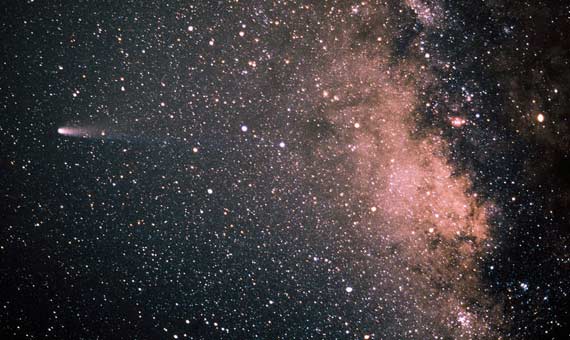On April 11, 1986, millions of people around the world looked to the night sky to welcome Halley’s Comet. On that day the celestial traveller, who returns to our neighbourhood every 75 or 76 years, reached its closest approach to the Earth. On its way in from the far reaches of the Solar System, the comet had approached 93 million kilometres from the Earth on November 27 of the previous year, reaching its perihelion (closest approach to the Sun) on February 9, 1986. It was during the trip back when it could be most easily seen, being only 63 million kilometres away from the Earth.

That visit of the comet, the last to date, was also the first one of the Space Age, so it became an opportunity to submit Halley to full scientific scrutiny. The Soviet probes Vega 1 and 2, the European Giotto and the Japanese Suisei and Sakigake, and other space and ground-based observatories, all documented the structure and composition of the comet like never before. However, for the general public the event was somewhat of a disappointment. The distance of Halley’s Comet from the Earth was the greatest in the past 2,000 years, a far cry from that of April 10 in the year 837, when it approached our planet from a distance of only 4.94 million kilometres. Given the comet’s remoteness this time round, not to mention the air and light pollution when the skies were clear, many people didn’t even catch a glimpse of it.

The passage of the comet in 1986 was much more discreet than in earlier times when its appearance was associated with major disasters. Even on its previous visit, in 1910, people were fearful of the apocalypse, although on that occasion it was a scientist who promoted the doomsday idea. On February 8 of that year, The New York Times reported that the Yerkes Observatory at the University of Chicago had detected deadly cyanogen gas in comet Halley’s tail, which would sweep across the Earth. And the astronomer Camille Flammarion’s prediction was not very promising: “The cyanogen gas would impregnate the atmosphere and possibly snuff out all life on the planet.”
Halley’s appearances have been recorded from at least the year 240 BC, and perhaps earlier. The Jewish Talmud includes an allusion to the comet, which also appears in the painting of Giotto as the star of Bethlehem that guided the Magi, although the dates do not match. But it was not until 1705 that the son of a wealthy soap manufacturer joined the historical points and mathematically described the astronomical object that bears his name.

Edmond Halley (8th November 1656-25th January 1742) was born in Haggerston, in London’s East End. His talent for science would take him at the age of only 19 to become the assistant of the first Royal Astronomer, John Flamsteed, and by 22 he was already a member of the Royal Society. His interests were many, and his career prolific: he studied celestial bodies and terrestrial magnetism, built the first rudimentary liquid compass, invented a diving bell, proposed a theory of the Hollow Earth, took part in the first scientific attempt to date Stonehenge and commanded the ship HMS Paramour on a journey to the South Atlantic to study the magnetic declination.
It is to Halley that we also owe the publication of Isaac Newton’s Principia, as it was he who financed the publication of the work of his friend. It is said that in 1684, during the debate on the laws of the motion of the planets enunciated by Kepler at the beginning of the century, Halley visited Newton in Cambridge to consult with him on the matter. The absent-minded genius confessed that he had already solved the calculations, but had lost the papers. Halley urged him to repeat the work, and from that determination would be born the fundamental work of Newton.
But Halley also took advantage of the incomplete treatment that Newton had devoted to the dynamics of comets to conceive of his own great discovery. In 1705 he published his book Synopsis Astronomia Cometicae, which concluded that the sightings of 1456, 1531, 1607 and 1682 corresponded to the same comet, which should return in 1758. He did not live to see his hypothesis confirmed, but when it proved to be true, the punctual celestial traveller was given the name Halley.
The comet will continue to turn up for its appointments with the Earth, with its next perihelion scheduled for July 28, 2061. But among all its visits, perhaps the most famous story is one starring the American writer Mark Twain. The satirist was born on November 30, 1835, two weeks after the comet’s perihelion. In 1909 he wrote: “I came in with Halley’s comet in 1835. It is coming again next year, and I expect to go out with it. It will be the greatest disappointment of my life if I don’t go out with Halley’s comet. The Almighty has said, no doubt: Now here are these two unaccountable freaks; they came in together, they must go out together.” And so it was. Twain died of a heart attack on April 21, 1910, the day after the perihelion of Halley.
By Javier Yanes for Ventana al Conocimiento
@yanes68
Comments on this publication